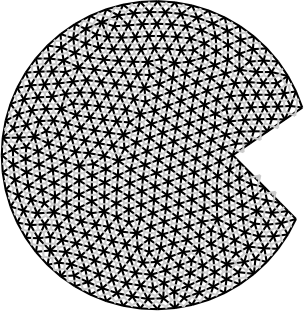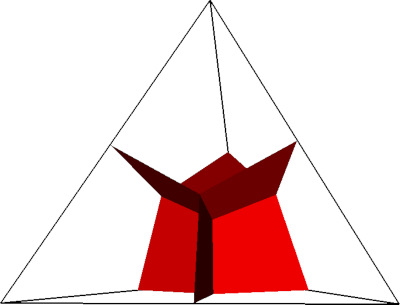https://github.com/meshpro/meshplex
:spider_web: Compute interesting points, areas, and volumes in simplex meshes of any dimension.
https://github.com/meshpro/meshplex
mathematics mesh pypi python voronoi-diagram
Last synced: 3 days ago
JSON representation
:spider_web: Compute interesting points, areas, and volumes in simplex meshes of any dimension.
- Host: GitHub
- URL: https://github.com/meshpro/meshplex
- Owner: meshpro
- Created: 2017-01-30T19:58:31.000Z (almost 9 years ago)
- Default Branch: main
- Last Pushed: 2025-03-24T14:52:21.000Z (9 months ago)
- Last Synced: 2025-04-26T23:36:15.823Z (8 months ago)
- Topics: mathematics, mesh, pypi, python, voronoi-diagram
- Homepage:
- Size: 4.83 MB
- Stars: 105
- Watchers: 2
- Forks: 22
- Open Issues: 7
-
Metadata Files:
- Readme: README.md
- Changelog: CHANGELOG.md
Awesome Lists containing this project
- awesome-scientific-computing - meshplex - Fast tools for simplex meshes. (Meshing / Mesh tools)
README
Fast tools for simplex meshes.
[](https://pypi.org/project/meshplex/)
[](https://pypi.org/project/meshplex/)
[](https://github.com/nschloe/meshplex)
[](https://pypistats.org/packages/meshplex)
[](https://discord.gg/hnTJ5MRX2Y)
Compute all sorts of interesting points, areas, and volumes in simplex
(triangle, tetrahedral, n-simplex) meshes of any dimension, with a focus on
efficiency. Useful in many contexts, e.g., finite-element and finite-volume
computations.
### Installation
Install meshplex [from PyPI](https://pypi.org/project/meshplex/) with
```
pip install meshplex
```
For full usage of meshplex, you require a license. Licenses for personal and
academic use can be purchased
[here](https://buy.stripe.com/5kA3eV8t8af83iE9AE). For more info, see
[here](https://github.com/meshpro).
### Quickstart
meshplex can compute the following data:
```python
import meshplex
# create a simple Mesh instance
points = [[0.0, 0.0], [1.0, 0.0], [0.0, 1.0]]
cells = [[0, 1, 2]]
mesh = meshplex.Mesh(points, cells)
# or read it from a file
# mesh = meshplex.read("pacman.vtk")
# triangle volumes, heights
print(mesh.cell_volumes)
print(mesh.signed_cell_volumes)
print(mesh.cell_heights)
# circumcenters, centroids, incenters
print(mesh.cell_circumcenters)
print(mesh.cell_centroids)
print(mesh.cell_incenters)
# circumradius, inradius, cell quality
print(mesh.cell_circumradius)
print(mesh.cell_inradius)
print(mesh.q_radius_ratio) # d * inradius / circumradius (min 0, max 1)
# control volumes, centroids
print(mesh.control_volumes)
print(mesh.control_volume_centroids)
# covolume/edge length ratios
print(mesh.ce_ratios)
# count Delaunay violations
print(mesh.num_delaunay_violations)
# get all boundary angles in radians
print(mesh.outside_boundary_angles_radians)
# removes some cells
mesh.remove_cells([0])
```
For triangular meshes (`MeshTri`), meshplex also has some mesh manipulation routines:
```python
mesh.show() # show the mesh
mesh.angles # compute angles
mesh.flip_until_delaunay() # flips edges until the mesh is Delaunay
```
For a documentation of all classes and functions, see
[readthedocs](https://meshplex.readthedocs.io/).
(For mesh creation, check out
[this list](https://github.com/nschloe/awesome-scientific-computing#meshing)).
### Plotting
#### Triangles

```python
import meshplex
mesh = meshplex.read("pacman.vtk")
mesh.show(
# show_coedges=True,
# control_volume_centroid_color=None,
# mesh_color="k",
# nondelaunay_edge_color=None,
# boundary_edge_color=None,
# comesh_color=(0.8, 0.8, 0.8),
show_axes=False,
)
```
#### Tetrahedra

```python
import numpy as np
import meshplex
# Generate tetrahedron
points = np.array(
[
[1.0, 0.0, -1.0 / np.sqrt(8)],
[-0.5, +np.sqrt(3.0) / 2.0, -1.0 / np.sqrt(8)],
[-0.5, -np.sqrt(3.0) / 2.0, -1.0 / np.sqrt(8)],
[0.0, 0.0, np.sqrt(2.0) - 1.0 / np.sqrt(8)],
]
) / np.sqrt(3.0)
cells = [[0, 1, 2, 3]]
# Create mesh object
mesh = meshplex.MeshTetra(points, cells)
# Plot cell 0 with control volume boundaries
mesh.show_cell(
0,
# barycenter_rgba=(1, 0, 0, 1.0),
# circumcenter_rgba=(0.1, 0.1, 0.1, 1.0),
# circumsphere_rgba=(0, 1, 0, 1.0),
# incenter_rgba=(1, 0, 1, 1.0),
# insphere_rgba=(1, 0, 1, 1.0),
# face_circumcenter_rgba=(0, 0, 1, 1.0),
control_volume_boundaries_rgba=(1.0, 0.0, 0.0, 1.0),
line_width=3.0,
)
```